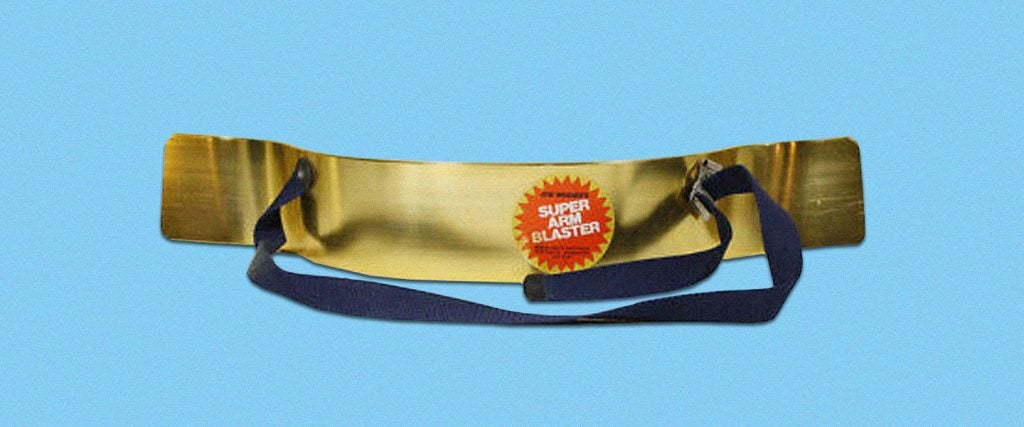I’ll never forget the moment I crossed paths with a genuine Arm Blaster training device in the wild (so to speak). The bizarre metallic contraption was suspended from the neck of Amir, a fellow personal trainer at Bally Total Fitness. “What is that?” I couldn’t help but ask him.
“An Arm Blaster,” he replied with a proud smile. “Arnold used to lift with it. That’s how he got his big arms.”
That was news to me. I’d watched Pumping Iron just like any other self-respecting aspiring meathead — and that film has plenty of footage depicting Arnold’s workouts — but I certainly couldn’t recall any Arm-Blaster sequences. The other curious thing about all of this was that Amir was a med-school student with tons of healthful information, but not the kind of physique that would have led you to believe he was a personal trainer.
What even is an Arm Blaster?
It’s a harness that hangs from your neck, and suspends a contoured plate just below your chest. The plate is configured to prevent your arms from creeping back past your shoulder as you do curls, enabling you to maintain a maximum amount of tension on your biceps while performing curls. Many people execute curls in a manner that causes them to perform two or more key errors: Either they permit their elbows to creep backwards, or they partially shrug the weight up as they lift it, removing much of the tension from the bicep, and easing the actual lifting of the weight.
Because of the way an Arm Blaster is arranged, it all but negates shrugging as a means to elevating the weight, while completely stripping the weight of its ability to slip behind you, which runs the risk of turning a classic barbell or dumbbell curl into a drag curl — a very effective exercise for developing the long head of the bicep, but which isn’t great for overloading the bicep or supinating it to improve the force of the contraction. Both of these actions are easier to perform when the weight is out in front of your body.
I’m running out to buy one immediately.
I’d prefer that you didn’t — for a couple of reasons.
First, a contraption like the Arm Blaster might seem like a blessing, but it may end up being your undoing because of the overwhelming temptation to rely too heavily on it as a curling assister rather than an arm-slide inhibitor. If you weren’t wearing the Arm Blaster and the weight of the curl bar was too heavy for you, you could either cheat in some form to elevate the weight — not the worst thing in the world if you intend to resist it on the way down and train the eccentric phase of the lift — or you could chalk up the rep as a failure, set the weight down and try it again later. Which isn’t the end of the world either.
When the Arm Blaster is on in such scenarios, however, it creates leverage to help you lift the weight — a fantastic way to cause an injury to your arms.
Second, the full, proper contraction of the bicep involves the partial elevation and contraction of the shoulder because of the way it ties directly into the shoulder joint. Ideally, then, your bicep-curl form would have a slight shoulder lift built into it, not a backwards pull that leverages the surface supporting your arm. Inhibiting a backward slide is fine, but unless you’re still able to elevate at the shoulders to complete the fullness of the contraction, you’re probably going to miss out on the full benefits of the curling movement.
Okay, I guess I’m NOT running out immediately to buy one.
Good call. Because while there are many parts of Arnold’s training regimen worth emulating, strapping on an Arm Blaster — arguably the gym broiest move you can make — isn’t one of them.

